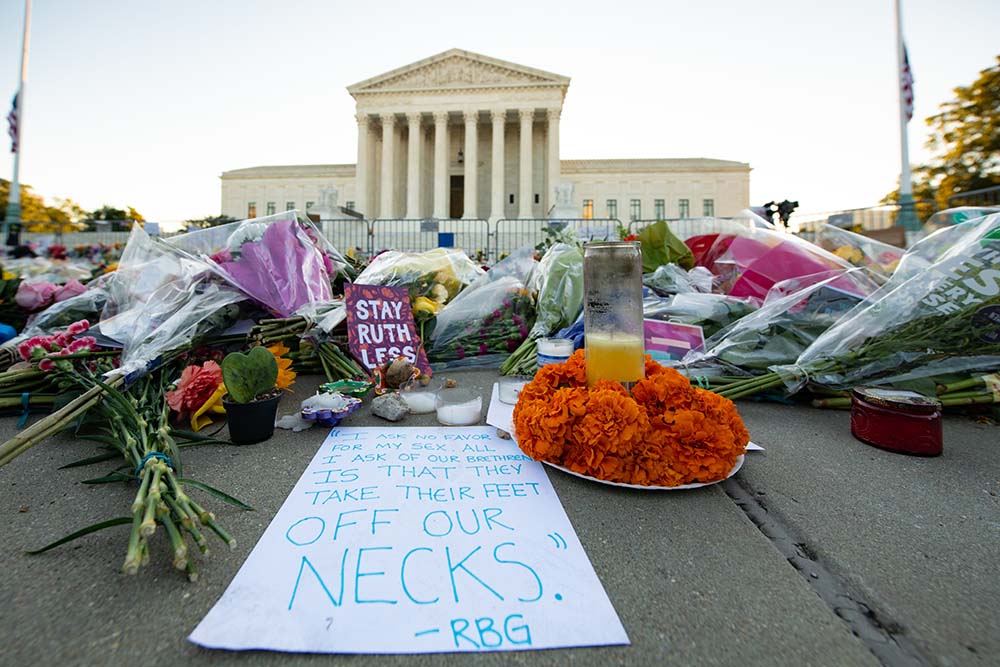Republicans will most assuredly attempt to rush confirmation of a conservative judge in a power play that could have dire implications for the landmark Roe vs. Wade case, which affirmed the right to abortion in 1973.
The death of a Supreme Court Justice this close to a presidential election has left many people wondering, what happens now, and what can we do?
Who will replace Ruth Bader Ginsburg on the Supreme Court?
Immediately following Ginsburg’s passing, Democrats hoped that enough Republican senators would refuse to vote on a Supreme Court nomination this close to a presidential election. After all, that was the justification provided by many GOP Senators following the death of Justice Antonin Scalia in 2016.
Then, Senate Majority Leader Mitch McConnell of Kentucky famously remarked,
“Rarely does a Supreme Court vacancy occur in the final year of a presidential term … Given that we are in the midst of the presidential election process, we believe that the American people should seize the opportunity to weigh in.”
Scalia died in February — a full 8 months before the election — but Republicans still refused to even consider Obama’s nomination of Merrick Garland. Now, with Ginsburg’s death occurring only six weeks before the election, McConnell and his colleagues have changed their tune, vowing that a Trump nominee will receive a vote on the floor of the Senate this year.
Drawing attention to their blatant hypocrisy or appealing to their better natures is pointless. The GOP has shown they will do whatever serves their best interests.
In a tweet Tuesday, president Trump stated that he would announce his Supreme Court nominee at 5 p.m. on Saturday. He has also stated it will be a woman. According to several people familiar with the deliberations, his clear front-runner is Amy Coney Barrett, who currently sits on the United States Court of Appeals for the Seventh Circuit in Chicago. Barrett was a finalist for the SCOTUS seat that ultimately went to Brett Kavanaugh in 2018.
The Supreme Court confirmation process
A Supreme Court Justice must be approved by a majority vote in the Senate, or 50 Senate votes with the vice president acting as a tie-breaker. As of this writing, it’s looking like they’ll hit that mark.
Republicans currently hold 53 Senate seats. A nominee can be blocked if four or more Republicans oppose, assuming all Democrats are also opposed.
Thus far, only two Republican senators — Susan Collins of Maine and Lisa Murkowski of Alaska — have stated they oppose a vote prior to the election.
In a statement on Twitter on September 19, Collins said,
“Given the proximity of the presidential election … I do not believe the Senate should vote on the nominee prior to the election. In fairness to the American people, who will either be reelecting the president or selecting a new one, the decision on a lifetime appointment to the Supreme Court should be made by the president who is elected on November 3rd.”
Murkowski became the second senator to oppose a vote prior to the election, telling a public-radio interviewer,
“I would not vote to confirm a Supreme Court nominee. We are 50 some days away from an election.”
However, two of the other senators who were considered by many to be possible holdouts — Cory Gardner of Colorado and Chuck Grassley of Iowa — have said they would support proceeding with a confirmation vote. And in a profoundly disappointing move, Mitt Romney of Utah — the only Republican who defied the party and voted to impeach Trump — has stated that if a nominee reaches the senate floor, he intends to “vote upon their qualifications.” Romney’s support essentially ensures the Senate will move forward with a vote this year. We can hope those qualifications are found lacking, but given that all Republicans voted to confirm Brett Kavanaugh, that isn’t likely. (Romney was not in office at the time, but has said he would have supported Kavanaugh’s nomination.)
However, the nominee must undergo a process that includes public vetting, committee vetting, private meetings with senators, and public hearings. The primary hope for Democrats at this point is to hope something goes sideways during that process.

How long does it take to confirm a Supreme Court nominee?
It typically takes more than two months from nomination to confirmation, which would extend the process past election day. At this point, the Republican Senate majority is in jeopardy; 13 Republican-held seats have been identified as potentially competitive by the Washington Post.
However, even if enough Senate seats are flipped in the election, Republicans will hold the Senate until January 3rd, giving them enough time to confirm Trump’s nominee.
Can Democrats flip the Senate?
Flipping the Senate to a Democratic majority is just as crucial as voting Trump out of office. If Biden is elected but Republicans keep control of the Senate — as they did for most of Obama’s presidency — all of Biden’s efforts will be blocked, and no meaningful reform will pass.
In order to reclaim the Senate majority, Democrats need to flip at least four seats, and keep the ones they currently have. If Biden is elected, Democrats would need a net gain of only three seats, as the vice president can vote to break ties in the Senate.
Polls currently show that Republican hopes of holding the Senate are very much in doubt. Democratic challengers have good changes of ousting Republican incumbents in Arizona, Maine, and Colorado. South Carolina and Iowa could also flip under the right conditions.
Democrats also need to defend Doug Jones in Alabama, the most vulnerable Democratic senator in one of the most pro-Trump states.
The most vulnerable Republicans up for reelection
Republican senate seats are particularly vulnerable in these key states:
Colorado. A recent poll shows Democrat John Hickenlooper leading 51 percent to incumbent Cory Gardner’s 46 percent. Pundits say Gardner has aligned himself too closely with Trump in a state in which the president holds a mid-30s approval rating.
Arizona. Former astronaut and gun-safety activist Mark Kelly (and husband of former congresswoman Gabby Giffords) is one of the Democrats’ strongest candidates of 2020. A recent poll in Arizona shows Kelly leading by seven percentage points. Arizona went narrowly for Trump in 2016 and has trended more blue since then. The Arizona race is of particular interest: If Kelly wins, Arizona state law would make him eligible to take over John McCain’s former Senate seat as early as November 30. If that happens, Kelly could narrow Republicans’ Senate majority in a post-election, lame-duck session during which Trump’s SCOTUS nominee could well be facing confirmation.
Maine. A recent poll shows Sara Gideon leading incumbent Collins 54 percent to 42 percent — and Collins with a high disapproval rating in her state.
Iowa. Trump won Iowa by nearly 10 percentage points in 2016, but Democrats now have a voter registration advantage over Republicans in the state, and a new poll of likely voters shows Republican Senator Joni Ernst only slightly ahead of Democratic challenger Theresa Greenfield. Polls also show Trump only narrowing leading Biden.
South Carolina. A new poll shows Democrat Jaime Harrison tied with incumbent Lindsey Graham. Harrison has been raising a staggering amount of money and giving Graham one of his toughest reelection fights ever. Pundits say Harrison, who is Black, is rallying Black voters. He’s also doing well with moderate, independent white voters.
North Carolina. A CNN poll shows this race basically tied, with 47 percent of likely voters saying they back Democratic nominee Cal Cunningham, over 46 percent backing incumbent Thom Tillis. Tillis narrowly won his first term six years ago, and Democrats have since made major gains in the state.
What about Kentucky? Though it looks unlikely, we’d be remiss not to mention Kentucky, where Democratic nominee Amy McGrath raised millions following Ginsburg’s death. Some political analysts, however, claim that these donations won’t make much difference, as polls currently show McConnell leading by 15 points. But the president’s numbers are sinking even in this red state, and McConnell’s lead is narrower than some expected, with independent voters backing McGrath.
What can you do?
These final weeks leading up to the election are crucial. Take nothing for granted. If the first 9 months of 2020 are any indication, we’re in for more surprises as election day draws nearer. Take action now to help protect democracy and ensure that your vote is counted.
1. Donate. If you’re able, donate to the key Senate campaigns listed above. It doesn’t matter if you live in those states. You can donate through ActBlue, a nonprofit organization that facilitates fundraising for Democratic candidates. You can also donate to the Ditch Mitch Fund, which is solely dedicated to supporting McGrath and ousting McConnell.
2. Volunteer. If you live in a key battleground state, visit your candidate’s website and find out how you can get involved. Many candidates need volunteers for phone banking, and provide training about how to talk to others in your community about why they should vote for a progressive candidate. If you aren’t comfortable talking on the phone, you can sign up for text banking, which is easier to do and allows you to contact hundreds of people at once. With text banking platforms, you don’t even have to type — scripts are loaded into the program for you to use. Yes, you will get some colorful responses, but you can also have some really hopeful and uplifting conversations.
3. Make a voting plan. Factors such as COVID-19, expanded mail-in voting options, massive disinformation campaigns, and a possible lengthy wait for results makes this year’s election unlike any others we’ve seen. Don’t wait until November 2nd to decide how and when you’ll vote. Lay out the steps you need to take to successfully cast your vote. Will you vote in-person or by mail? Does your state allow early voting? Due to the COVID-19 pandemic, many states have updated and expanded voting options, with no-excuse absentee ballots, early voting, and other measures to allow citizens to vote safely. If you’re voting in person, make sure you bring your ID. To be safe, bring a photo ID such as your driver’s license or a passport. In some states, you can use a current utility bill, paycheck, or other document that shows your name and street address.
4. Confirm your voter registration. Make sure you’re registered to vote. Double check your voter registration and polling location. If you aren’t yet registered, do so now.
5. Know your candidates and your issues. Research the candidates and issues that will be on your ballot. While the Presidential election generates the most attention, local and state elections are also extremely important. Visit BallotReady to research your ballot so you can make an informed vote.
6. Help others cast their vote. Check with your community and your own personal network to see if you can help others who need assistance voting. Some people, especially older people, disabled voters, and those in lower income communities may have difficulty voting due to transportation issues. If you have reliable transportation, consider volunteering to drive others to the polls.
7. Keep fighting for justice. It’s what Ruth would want.





